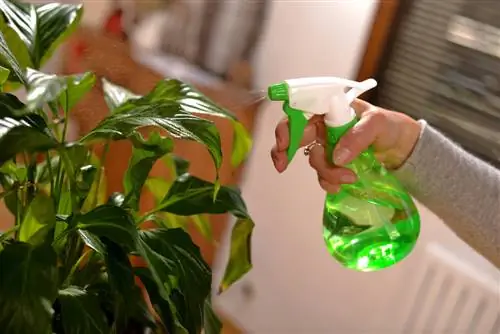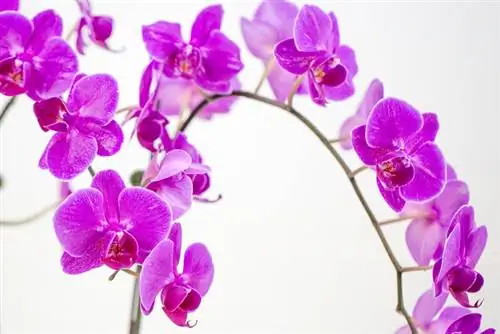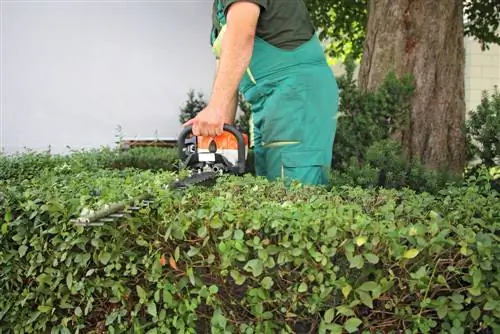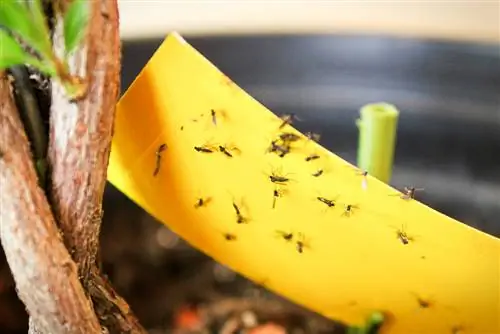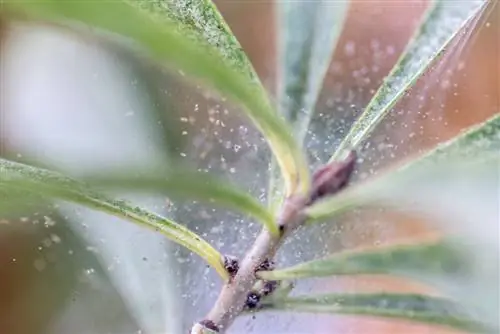- Author admin [email protected].
- Public 2024-01-05 20:48.
- Last modified 2025-01-23 11:22.
If the leaves of your houseplant suddenly have a sticky coating, pests are usually to blame. Read here which types of pests are possible and what measures you can take to combat the symptoms.

What causes sticky leaves on houseplants?
Sticky leaves on houseplants are usually caused by pests such as aphids or scale insects, which excrete a sticky substance called honeydew. To treat the infestation, you can, among other things, shower the plant, use natural sprays or beneficial insects and remove infected parts of the plant.
Causes of sticky leaves
While dried plant parts or discolored leaves are usually the result of care errors, a sticky coating on the leaves usually indicates a pest infestation. Lice in particular cause the shiny to white-brownish film. Due to its appearance and sticky consistency, the symptom is often referred to as powdery mildew or honeydew. Nevertheless, a care error can be a major problem. On the one hand, the lice feel comfortable in very high humidity and warm temperatures. Heated air and a location in the blazing sun promote the appearance of pests. Intensive watering also promotes humidity in the area. In addition, the pests mainly nest on plants that are already weakened. Care errors damage the vitality of the houseplant.
Flour or honeydew definition
Mildew or honeydew is the excretions of aphids or scale insects. First they suck the juice from the leaves and then leave behind the symptoms mentioned. In contrast to the sticky honeydew, you can wipe off mildew with your finger. You're probably annoyed by sticky car windows or sticky sidewalks in the summer. This phenomenon particularly occurs under linden trees. This is also honeydew.
Note: Honeydew on houseplants is undesirable and can cause massive damage to the plant. For example, he calls the sooty mold fungus onto the scene. On the other hand, honeydew plays an important role in the ecosystem. The sticky substance even appears in your diet without you being aware of it. It serves as a valuable source of food for many insect species. Bees collect the substance from the leaves and use it to produce intensely bitter tasting forest honey.
Consequences
As already mentioned, an infection with the black mold or sooty mold can be the result of honeydew. In addition, the sticky liquid attracts ants. Since they feed on honeydew, they enter into a symbiosis with aphids. In return, they protect the pests from predators.
Treatment measures
To get rid of honeydew permanently, you have to treat the cause of its formation, i.e. the aphids. The following methods have proven to be effective:
- if there is a small infestation: shower the plant
- Make sprays from neem or rapeseed oil and water
- Dissolve soft soap in water and spray on the leaves
- Release beneficial insects such as lacewings or parasitic wasps on the plant
- Make nettle stock
- remove affected plant parts
Note: Chemical agents against scale insects and aphids are available commercially. Of course, this form of treatment is very promising and simple, but fungicides are still strongly discouraged. On the one hand, you are damaging the houseplant, and on the other hand, you are endangering your own he alth and that of those around you.

